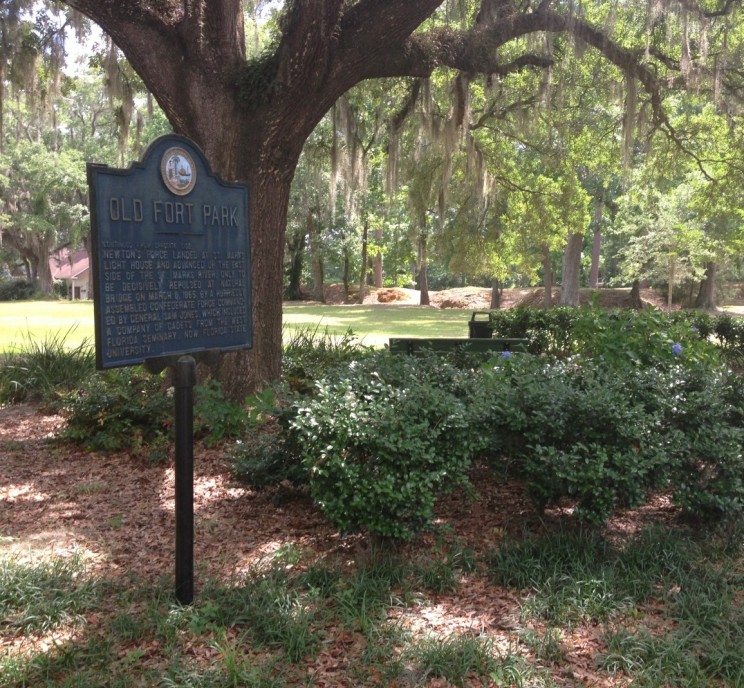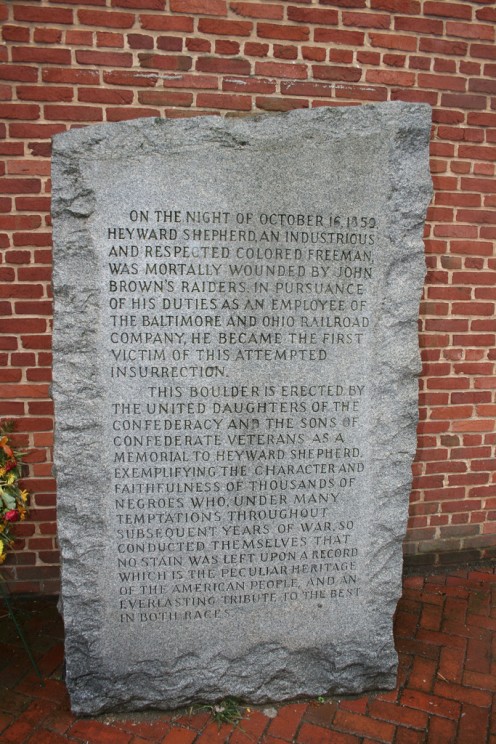By Jessica H. Clark
Just east of downtown Tallahassee, Florida, there is a small city park known as “Old Fort.” It contains precisely that – a square of softly eroding earthworks (all that’s left of the fort) along with a few benches placed benignly in the shade of nearby oak and pine trees. The historical marker in the park offers some explanation:
“This earth work located on ground once part of the plantation of E.A. Houston…who commanded the Confederate artillery at the Battle of Natural Bridge, is a silent witness of the efforts of the citizens of Tallahassee to protect the capitol of Florida from capture when threatened by federal troops under General John Newton. Newton’s force landed at St. Marks light house [sic] and advanced up the east side of the St. Marks River, only to be decisively repulsed at Natural Bridge on March 6, 1865, by a hurriedly assembled Confederate force commanded by General Sam Jones, which included a company of cadets from the West Florida Seminary, now Florida State University.”

Civil War marker in Old Fort Park, Tallahassee, Florida. Photo by Jessica H. Clark. Used with permission.
So the marker claims the park as a victory monument of sorts. It was here in 1865 that soldiers of the army of the Confederate States of America waited for an invading force that never came. The interpretive marker is genteel and uncommitted, allowing for assumed knowledge on the part of its reader to complete the story it would rather not to tell. So in some ways, the work of remembering our Civil War is not unlike dinner at Downton Abbey — words need not match their meanings to be perfectly well understood, if understood differently, by those who hear them.
The Romans knew that remembering was never that simple. The Roman historian Tacitus wrote a wonderful piece describing events in the year 69 or 70 C.E., which illustrates what we risk when we try to make the ground bear witness to a convenient past. According to Tacitus’s account, a man named Julius Civilis was leading a rebellion against Roman occupation east of the Rhine. He attacked two Roman legions and forced them back to their camp at Vetera (modern Xanten), and eventually convinced them, after a lengthy siege, to surrender in exchange for their lives. However, several of Civilis’s allies broke the truce and ambushed the retreating Romans, killing many and driving the rest back to Vetera. Civilis and his men finished off these unarmed Romans and burned the camp to the ground.

Table-top model of Roman Xanten (Castra Vetera), Archäologischer Park Xanten. Photo by Аlexej Potupin via Wikimedia Commons.
Not long afterwards, as Civilis and his men prepared for another battle at Vetera, Tacitus describes him giving a speech to his men in which he “[calls] the site of the battle a ‘witness to valor’” and that “they stood on footprints of glory, walking on the ashes and bones of legions.” But Civilis errs; having flooded the original battle site to disadvantage the Roman legions, Civilis knows that his speech does not match reality. A poor student of history, he is too eager in his facile assumptions of the relationship between physical remains and the memory of war.
The sense of physical connection is important, though, and so in place of real ashes beneath their feet, he gives his men the next best thing. He asks them to imagine the bones of their enemies, just as their commander imagines that their bloody indiscipline could be monumentalized into a glorious victory. Tacitus creates a striking metaphor for civil war commemoration: imaginary monuments invoking false memories, inspiring fictive reinterpretations of a better past that never was.
This, of course, never does anyone any good. Civilis was bound to fail because he did not learn from his mistakes, and did not learn from them because he chose, instead, to tell a story where they had no place.
Thus can the lies we tell ourselves about our wars exact a higher price, in the long term, than the conflicts themselves. This isn’t just ancient news, either; as recently as 2000, the US Congress asked the Department of the Interior to “compile a report on the status of our interpretation of battlefield sites.” The National Park Service conducted an investigation and concluded that it was time to “develop a new paradigm” for the national commemoration of the American Civil War. The report sets forth, as an exemplar, Harpers Ferry, Virginia, where (what is often seen as) a pro-slavery monument was restored but matched by an interpretive plaque commemorating, effectively, the ways in which the stories we tell now are different from those we have told in the past.

This monument in Harpers Ferry, West Virginia, which commemorates free black man Heyward Shepherd — killed during John Brown’s raid in 1859 — for his “faithfulness” to the Confederacy, has been the subject of debate for several decades. CC BY-NC 2.0, photo by Slave2TehTink via Flickr.
The pairing of monument and plaque, unsurprisingly, caused enormous controversy. And what it underscores is, I think, one of Tacitus’s points for the preservation of civil society: the very aspects of the past that threaten our foundational illusions are the ones that have the most to offer our future.
The marker at the Old Fort in Tallahassee calls the earthwork a “silent witness,” an idea also deployed with great force in Eric Bogle’s 1976 World War I song “No Man’s Land”:
But here in this graveyard that’s still No Man’s Land
The countless white crosses in mute witness stand
To man’s blind indifference to his fellow man
And a whole generation that was butchered and damned.
In March of 2014, President Obama spoke at Flanders Field American Cemetery. While some parts of his remarks were deeply moving, at one point he invoked the hundreds of thousands of dead who lay beneath that ground: “Belgian and American, French and Canadian, British and Australian, and so many others…while they didn’t always share a common language, the soldiers who manned the trenches were united by something larger — a willingness to fight, and die, for the freedom that we enjoy as their heirs.”

Robert Vonnoh (American, 1858-1933), “Coquelicots” (“Poppies”), 1890; retitled in 1919 as “Flanders – Where Soldiers Sleep and Poppies Grow.” Butler Institute of American Art, photo from Exhibition Catalogue Americans in Paris, Metropolitan Museum via Wikimedia Commons.
Those soldiers presumably would have died for freedom, as would the “so many others” (better known to history as Germans), had they been called to do so — but the First World War was not about that. We make false witness of the past and then wonder why it does not teach our children the truth; and while we may take some comfort from our consistency, Tacitus and the Park Service should remind us that we can do better.
Jessica H. Clark is Assistant Professor of Classics at Florida State University and the author of the book Triumph in Defeat: Military Loss and the Roman Republic.
Subscribe to the OUPblog via email or RSS.
Subscribe to only classics and archaeology articles on the OUPblog via email or RSS.
The post Wars and the lies we tell about them appeared first on OUPblog.



 Two-time Oscar nominee Woody Harrelson (pictured,
Two-time Oscar nominee Woody Harrelson (pictured, 










